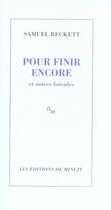Résumé:
These four stories or 'nouvelles' date from 1945, though all were published much later, in French and subsequently in English. All make use of a first-person narrator, and relish its vagaries - the inability to remember facts, the uncertainty as to why he is speaking in the first place, the loss... Voir plus
These four stories or 'nouvelles' date from 1945, though all were published much later, in French and subsequently in English. All make use of a first-person narrator, and relish its vagaries - the inability to remember facts, the uncertainty as to why he is speaking in the first place, the loss of heart when explanations seem called for... Above all, the stories crisply plot the narrator's plotless descent into vagrancy, the steeper as it approaches The End. Out of these short works and their patient procedures grew the large canvases of Molloy and Malone Dies. My bench was still there. It was shaped to fit the curves of the seated body. It stood beside a watering trough, gift of a Mrs Maxwell to the city horses, according to the inscription. During the short time I rested there, several horses took advantage of the monument. The iron shoes approached and the jingle of the harness. Then silence. That was the horse looking at me. Then the noise of pebbles and mud that horses make when drinking. Then the silence again. That was the horse looking at me again. Then the pebbles again. Then the silence again. Till the horse had finished drinking or the driver deemed it had drunk its fill. Edited by Christopher Ricks
Donner votre avis















